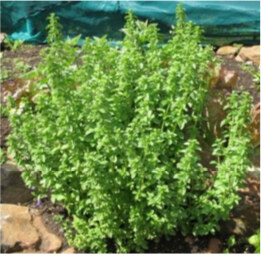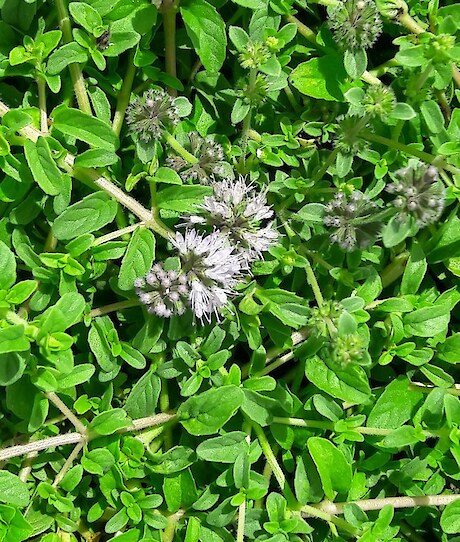Mentha pulegium
Download info sheetFor some of you, this herb will bring back childhood memories of being down by the creek in summer.
Identification: Pennyroyal, is a member of the mint and therefore the Lamiaceae family, and like many of its cousins, has bright green leaves and is quite a rampant grower. It sends out runners to colonise even more land. Despite being the
smallest leaved of the mint family, its fragrance and taste are the strongest. The flowers rise above the foliage and are a soft mauve and from a distance look like a misty haze. Ah! Then there’s the fresh minty smell under foot as it is crushed, remember that? It grows best in a cool damp spot and in fact can be quite rampant. Farmers often curse it for taking over their damp paddocks. It will be easier to control in a normal garden environment as you can restrict it by growing it in a drier position.
Energetic Character: Pungent, dry, cooling.  (Image: Raffi Kojian - http://Gardenology. org, CC BY-SA 3.0, https://commons.wikimedia.org/w/index.php?curid=12734737)
(Image: Raffi Kojian - http://Gardenology. org, CC BY-SA 3.0, https://commons.wikimedia.org/w/index.php?curid=12734737)
Constituents: include volatile oils and ketones (including pulegone, dipentene, menthone, menthol, isomenthone, neomenthone, l-pinene, l-limonene), menthofuran, tannins and bitter principles.
Therapeutic Actions: Colds, colic, congestion,
convulsions, cramps, fever, gout, headache, itching, lungs,
menstruation problems, emmenagogue, mucous, nausea, nerves, perspiration, rashes, skin disease, sunstroke, toothache and ulcers, insect repellent. Historically, if it was used internally, it was as a weak tea or vinegar. Here again we caution against internal ingestion of this herb. This is an interesting herb with a lot of history. It is very useful but must be respected due to its powerful constituents, especially when using the essential oil of Pennyroyal.
Preparations and Use: The best and safest way to use Pennyroyal is externally only.
*Caution: Pennyroyal is to be avoided if you are pregnant as the main volatile oil is a uterine stimulant. Also to be avoided by those with kidney disease. It is a very useful herb, BUT do not overuse externally or use at all internally, without guidance from a qualified Medical Herbalist. Leaves: Rub crushed Pennyroyal leaves on exposed skin as an insect repellent or on bites to relieve the itch. Pennyroyal can also be used the same way as an insect repellent for fleas on animals or place it in their bedding. The smoke of burnt pennyroyal is useful around a BBQ or campfire to repel insects too. It can also be dried and used in potpourri, another use, place either fresh or dried Pennyroyal on ant entry points or trails to act as a deterrent.
“If you have Pennyroyale in great quantity dry and cast it into corrupt water, it helpeth it much, neither will it hurt them that drink thereof.’ As a purifier of the blood, it was highly spoken of: ‘Penny-royale taken with honey cleanseth the lungs and cleareth the breast from all gross and thick humours.” – John Gerard (1545-1612), English Herbalist
Infusion: Fresh Pennyroyal infused in cider vinegar for 2 weeks is then strained and stored. Used for bruises, burns and skin marks. Historically the leaves were (Pennyroyal image: Karina Hilterman) infused in vinegar with wormwood and Chamomile flowers and taken in small doses to relieve seasicknes
(Pennyroyal image: Karina Hilterman) infused in vinegar with wormwood and Chamomile flowers and taken in small doses to relieve seasicknes
“Drank with wine, it is good for venomous bites, and applied to the nostrils with vinegar revives those who faintand swoon. Dried and burnt, it strengthens the gums, helps the gout, if applied of itself to the place until it is red, and applied in a plaster, it takes away spots or marks on the face; applied with salt, it profits those that are splenetic, or liver grown…. The green herb bruised and put into vinegar, cleanses foul ulcers and takes away the marks of bruises and blows about the eyes, and burns in the face, and the leprosy, if drank and applied outwardly…. One spoonful of the juice sweetened with sugar-candy is a cure for hooping-cough.” – Nicholas Culpepper (1616-1654), English Herbalist
Additional uses: Pennyroyal apparently is a dye plant however I am not certain of the colour obtained or the mordant needed. But if you are open to experimentation you can find out yourself.
History & Mystery: Some of the folk names for Pennyroyal include true pennyroyal, English pennyroyal, European pennyroyal, mock pennyroyal, spearmint (which is actually Mentha spicata), pudding grass, pulegium, polei, poleo, yarpuz, tickweed, stinking balm, thick weed, mosquito plant squaw mint, and squaw balm and so many more.
Culpepper, not only a great Herbalist but also an Astrologer, classified Pennyroyal as ruled by Venus; a herb for Librans. He described it as warming and soothing. Other historical references state that Pennyroyal is a masculine herb, ruled by Mars with a Fire element. Its deity representative is Demeter and that its powers are peace, protection and strength. This is the herb to ‘ward off the evil eye’! In a similar vein, here is what you have always wanted to know - how to break a hex or a curse. Pick Pennyroyal, chop it finely and mix with crumbled dried Nettle and soil gathered from a graveyard, sprinkle it on your hair and bedclothes (or those of the person affected) as you or they go to bed. It’s believed to assist solving disputes and to bring good luck – every home, council meeting room and parliament ought to have this herb growing! Pennyroyal has a long history of use; it is believed to be the ‘Kykeon herb’ used during the Greek Eleusian mysteries. The name pulegium is derived from the Roman tradition, from pulex, Latin for flea, due to its insect repellent properties. Dioscorides and Pliny both wrote of its many values.
 (Pennyroyal image: Karina Hilterman)
(Pennyroyal image: Karina Hilterman)
In the Middle Ages it was called puliol royale or royal thyme as it was thought to be related to thyme. Some other folk names are, run-by-the-ground or lurk in the ditch, relating to its growth habits.
Gerard, a great Herbalist from the past said that pennyroyal was so antiseptic it would purify “bad” water. It was taken dried on long sea voyages and put into the water casks to sweeten them. Pliny used to suggest that it was good to hang in sleeping rooms; perhaps, because it is a good insect repellent and ‘air freshener’? Garlands of Pennyroyal were worn on the head to treat headaches and ‘giddiness’. The Romans used to wear pulegium wreaths hoping to dispel drunkenness!!!
“Stones and certaine Beastes ‘states that, by putting drowning flies and bees in warm ashes of Pennyroyal ‘they shall recover their life after a little time.” - Albertus Magnus (Born sometime between 1193 and 1206-1280 aka Albert the Great of Cologne) The Book of Secrets of Albertus Magnus: Of the Virtues of Herbs, Stones, and Certain Beasts, Also a ‘Book of the Marvels of the World.”
Prepared for the Herb Federation of New Zealand’s Herb Awareness Month 2021.
Enquiries: www.herbs.org.nz
Advisory Note: This text is given as a general guidance. If any adverse reactions occur or symptoms persist, please contact a qualified medical herbalist or medical doctor immediately.

